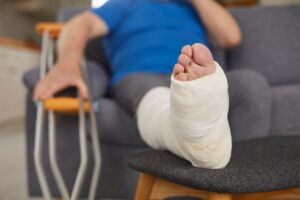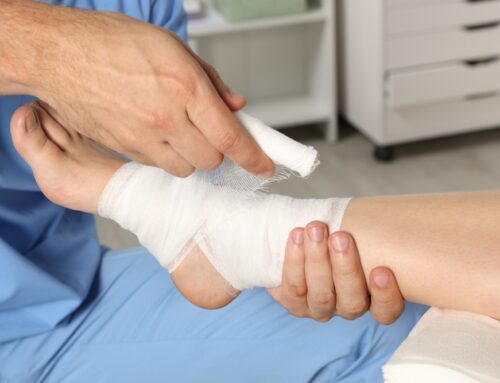With any injury, proper wound care can make a drastic difference in how long it can take for you to fully recover. There are many advanced wound healing methods that can be used to expedite your healing journey, but sometimes the simplest techniques, like leg elevation, can significantly accelerate the healing process. Throughout this article, we will break down how leg elevation works and how to properly elevate your legs to help reduce your recovery time.
The Science Behind Leg Elevation and Wound Healing
Leg elevation is one of these basic techniques that can be beneficial for anyone with venous insufficiency, chronic wounds, and surgical sites. When your legs stay below the level of your heart, it causes your blood to pool in your legs and increases the blood pressure in your veins. The higher pressure on your veins can slow down your circulation and make it easier for fluid to build up in your legs.
By elevating your legs to where they are above the level of your heart, you can leverage gravity to reverse the negative effect it previously had on your circulation. Since gravity is consistent, when you raise your legs it will start to pull excess fluid back towards your heart. As the fluid buildup in your legs slowly reduces, you’ll notice any edema caused from the pressure will begin to resolve as well.
Circulation plays a vital role in wound healing by acting as the delivery system of nutrients and oxygen to your wound. One of the most common issues with chronic wounds is a lack of oxygen and nutrients to the area, which greatly impedes new tissue growth. Regularly elevating your legs can help ensure that these essential wound-healing resources make it to your wound site and boost collagen production and cell regeneration.
Benefits of Leg Elevation for Wound Healing

As leg elevation becomes a regular part of your recovery process, you can begin to experience some of the benefits. The primary benefits are:
- Reduced Swelling: Giving the excess fluid buildup time to drain back up your legs can help relieve the pressure on the tissues in your legs, effectively preventing complications like tissue breakdown, delayed healing, or infection.
- Improved Circulation: In addition to increasing oxygen and nutrients to the wound, improved blood flow also ensures that waste products are removed from the area to prevent them from building up in your wound.
- Decreased Pain and Discomfort: Fluid buildup can cause pain, throbbing, and heaviness in your legs, but elevating your legs can reduce these sensations to help you stay mobile and pain-free.
- Faster Tissue Regeneration: Between the reduction of pressure, increased nutrition to the wound, and the improved waste removal, your body can start to form new tissue faster than before to close the wound more efficiently.
Each of these benefits can help reduce your recovery time and help you get back to your daily life.
Best Practices for Elevating Your Legs
Although elevating your legs may seem simple, there are a few steps you can take to ensure you are maximizing your results. To elevate your legs effectively, make sure to:
- Get in Proper Positioning: To get the blood and fluids to flow back up your legs, you have to raise your legs to where they are higher than your heart. You should elevate your legs at a 30 to 40 degree angle, which can be achieved by using a pillow underneath your legs.
- Determine the Frequency: Before you incorporate leg elevation into your regular routine, talk to your doctor about how long and how often you should do it based on your medical history and condition. As a general rule, you can elevate your legs for 15-30 minutes several times a day, especially after sitting or standing for long periods of time.
- Use Supportive Aids: Since you have to maintain proper positioning for leg elevation for an extended period of time, it’s recommended to use supportive aid, like pillows, wedges, or specialized medical devices to help you stay in position.
- Incorporate Movement: Although maintaining your position during leg elevation is important, you do want to incorporate gentle movement to keep from getting stiff and further aid circulation. Simple movements like rotating your ankles or flexing your feet can help.
By following these tips, you can ensure you are properly elevating your legs in hopes of getting the best outcome.
When Leg Elevation May Not Be Enough

Leg elevation can help support wound healing, but it is not a miracle cure. There are cases where raising your legs will not make enough difference in your condition. Some wounds can be too far gone to heal without medical intervention. Poor-healing wounds, or wounds that show no signs of improvement after four weeks, commonly present with:
- Excessive swelling
- Drainage or pus
- Foul odor
- Persistent redness
- Increased pain
- Warmth around the wound
In addition to a wound being slow to heal, there are many chronic conditions that can slow down your healing by hindering your blood flow. You should talk to your healthcare provider about managing underlying conditions such as:
- Diabetes
- Peripheral arterial disease
- Chronic venous insufficiency
- Cardiovascular disease
- Obesity
If you notice signs of infection, worsening systems, or tissue necrosis around your wound, seek immediate medical attention. For slow-healing or chronic wounds, you may need additional treatment using advanced wound care techniques like specialized dressings or debridement.
Additional Wound Care Tips to Enhance Healing

While you can use leg elevation to aid in wound healing, there are other methods you can use to promote a quicker recovery. Here are a few steps you can take at-home to help your wound heal:
- Keep Your Wound Clean: Preventing infection is vital to ensuring your wound can heal, so you should regularly clean your wound and cover it with sterile bandages to protect it from bacteria.
- Stay Hydrated and Eat Well: Wounds require plenty of nutrients and hydration to heal. To support your body’s tissue repair and immune function, you’ll need to incorporate foods full of vitamin C, vitamin A, and zinc. Protein can also help boost your collagen production.
- Compression Therapy: If your doctor recommends it, compression therapy can be used to help reduce swelling and push excess fluid back from your legs. Compression therapy can be used in combination with leg elevation to maximize your results.
Always make sure to follow your doctor’s orders with any chronic wound treatment, and never start a new treatment without consulting your doctor first.
Wound Healing With Innovative Wound Care
With our specialists at Innovative Wound Care, we can help evaluate your wound and determine if advanced wound therapy is a good option for you. We can help ensure your treatment is compatible with your medical history and mobility. Let us guide you through every step of your wound healing journey, from preparing your wound to learning how to use wound dressings.
At Innovative Wound Care in Flint, Michigan, we proudly offer treatments for:
- Diabetic and Neuropathic wounds and ulcers
- Minor burns
- Pressure injuries
- Lower extremity edema
We also offer some of the top treatment options for wounds, such as:
- Hyperbaric oxygen therapy (HBOT)
- Advanced wound dressings
- Compression dressings
- Debridement
- Negative pressure wound therapy
Allow our providers to properly assess your wound to expedite your healing journey. You should not have to suffer in silence when you have options available to treat and manage chronic wounds.
Contact us today to learn more about our options, and the next steps you can take for further healing. We look forward to hearing from you.






Leave A Comment